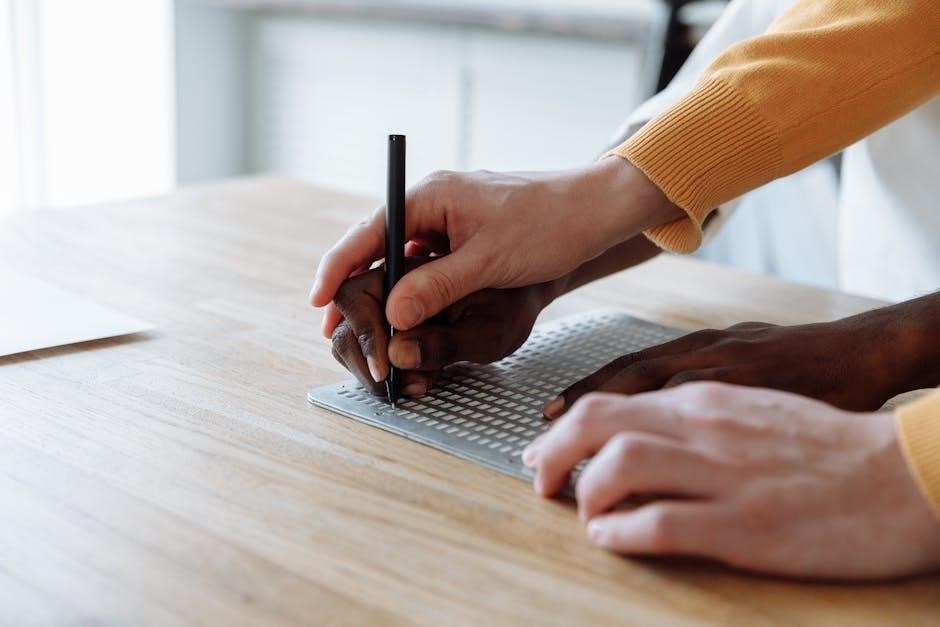James Hardie Board and Batten Siding combines timeless design with durable fiber-cement material, offering a classic aesthetic while resisting weather and pests, perfect for modern homes.
Overview of Board and Batten Style
The Board and Batten style is a classic design featuring wide siding boards paired with narrow battens, creating a clean, rustic aesthetic. Originating nearly two centuries ago, this timeless look is achieved by installing horizontal boards with battens covering the gaps between them. The style offers versatility, complementing both traditional and modern architectural designs. Its simplicity and durability make it a popular choice for homeowners seeking a balanced blend of form and function. The Board and Batten style is not only visually appealing but also enhances curb appeal, making it a sought-after option for those looking to combine tradition with contemporary elegance.
Benefits of Using James Hardie Products
James Hardie fiber-cement products offer exceptional durability, resisting warping, rotting, and damage from pests. They are fire-resistant and withstand harsh weather conditions, making them ideal for various climates. With a wide range of designs and finishes, Hardie boards provide a sleek, long-lasting aesthetic. Their low maintenance requirements and resistance to fading ensure a beautiful appearance for years. Additionally, James Hardie products are eco-friendly and come with a strong manufacturer warranty, offering homeowners peace of mind. These benefits make Hardie siding a cost-effective and sustainable choice for achieving both style and resilience in home exteriors.

Tools and Materials Required

Essential tools include circular saws, drills, and nail guns. Materials needed are James Hardie boards, battens, stainless steel nails, weather barrier, and zip flashing for sealing gaps.
Essential Tools for Installation

For a successful James Hardie Board and Batten Siding installation, essential tools include a circular saw for cutting boards, a drill for pre-drilling holes, and a nail gun for securing battens and boards. A level ensures proper alignment, while a measuring tape and square help with accurate cuts and placements. Pencil and marker are needed for marking surfaces. Safety gear, such as gloves and goggles, is crucial. Additional tools include weatherproof sealants for gaps and zip flashing tools to install flashing correctly. These tools ensure a professional and durable installation outcome, adhering to James Hardie’s guidelines for optimal performance and longevity.
Necessary Materials for Board and Batten Siding
The essential materials for James Hardie Board and Batten Siding include fiber-cement siding boards, battens (available in various widths), and trim for finishing edges. Fascia boards are required for eaves and rake areas, while zip flashing ensures watertight seals around battens. Stainless steel or galvanized fasteners, such as nails or screws, are recommended for durability. A weather-resistant barrier should be installed behind the siding to protect the wall structure. Additionally, caulk and sealants are needed to seal gaps and joints. These materials ensure a secure, weather-tight, and visually appealing installation that meets James Hardie’s quality standards and enhances your home’s exterior durability.
Recommended Fasteners for Hardie Board Installation
For a secure and durable installation, James Hardie recommends using stainless steel or galvanized finish nails with a 1-1/2″ to 2″ length. These fasteners resist corrosion and ensure long-lasting performance. When installing battens and trim, stainless steel screws or ring-shank nails are ideal for their superior holding power. Always follow James Hardie’s specific fastening guidelines to maintain warranty validity and structural integrity. Proper spacing and depth of fasteners are critical to avoid damaging the siding and ensure a tight seal. Using the right fasteners enhances the overall durability and appearance of your Board and Batten siding installation.

Preparation for Installation
Ensure structural integrity by checking local codes, installing a weather barrier, and preparing the wall surface. Compliance and proper preparation prevent water damage and ensure a secure fit.
Checking Local Building Codes and Regulations
Before starting your James Hardie Board and Batten Siding installation, ensure compliance with local building codes and regulations. Visit www.hardiezone.com to determine your specific zone requirements. Obtain necessary permits and verify that all materials meet local standards. Failure to comply may result in legal issues or voided warranties. Always adhere to James Hardie’s installation guidelines to maintain product integrity and safety. Consulting with local building authorities is recommended to avoid delays and ensure a smooth installation process.
Ensuring Proper Weather Barrier Installation
Proper weather barrier installation is crucial to protect your home from moisture damage. Use James Hardie’s HardieWrap weather barrier, ensuring it is tightly sealed around windows, doors, and electrical outlets. Secure the barrier with approved fasteners and tape seams to prevent gaps. Inspect the barrier for tears or damage before installing siding. A well-installed weather barrier prevents water infiltration, reducing the risk of rot and structural issues. Always follow James Hardie’s guidelines for weather barrier installation to maintain warranty validity and ensure long-term performance of your siding system.
Preparing the Wall Surface for Siding
Preparing the wall surface is essential for a smooth James Hardie Board and Batten installation. Ensure walls are clean, dry, and free from old adhesives, mold, or mildew. Inspect for structural damage and repair any cracks or holes. Check for levelness and plumbness, addressing any uneven areas. Remove existing siding if necessary and dispose of materials properly. Apply a weather barrier, like HardieWrap, ensuring it is tightly sealed around windows, doors, and electrical outlets. Secure the barrier with approved fasteners and tape seams to prevent gaps. Inspect the barrier for tears or damage before proceeding. A well-prepared surface ensures proper adhesion and long-lasting performance of your siding system.

Step-by-Step Installation Guide
Install siding boards, ensuring proper alignment and spacing. Add battens to create the board and batten effect. Seal gaps with Zip Flashing for weatherproofing. Finish with trim and fascia for a polished look.

Installing the Siding Boards
Begin by aligning the first siding board with the bottom of the wall, ensuring it is level. Secure each board using stainless steel finish nails, spacing them 16-24 inches apart. Start from the center and work outward to prevent warping. Cut boards as needed using a circular saw with a diamond blade. Install boards in a staggered pattern to avoid seams aligning, enhancing strength and appearance. Always follow James Hardie’s nailing instructions to maintain product warranty and structural integrity. Proper installation ensures durability and a professional finish.
Adding Battens for the Board and Batten Effect
Battens are vertical strips installed over the siding boards to create the board and batten effect. Begin by aligning battens with the seams of the siding boards, ensuring they are level. Secure each batten using stainless steel finish nails, spacing them 12-16 inches apart. Cut battens to fit the wall height, leaving a small gap at the top and bottom for expansion. Install battens evenly, avoiding alignment with nail holes in the siding. Proper spacing enhances the aesthetic appeal while maintaining structural integrity. Follow James Hardie’s guidelines for nailing patterns to ensure a secure and durable installation. This step transforms the siding into a classic board and batten design.
Sealing Gaps with Zip Flashing
Zip Flashing is a critical component for sealing gaps in James Hardie Board and Batten Siding, ensuring weather-tightness and preventing moisture infiltration. Apply Zip Flashing around windows, doors, and at the top of siding boards where battens meet. Cut the flashing to size using a utility knife and press it firmly into place, ensuring it adheres securely. This step is essential for maintaining the integrity of the siding system and protecting the wall cavity from water damage. Proper installation of Zip Flashing enhances durability and prevents costly repairs. Always follow the manufacturer’s instructions for optimal results and a professional finish.

Finalizing the Installation with Trim and Fascia
After installing the siding boards and battens, the final step is to add trim and fascia for a polished look. Trim is used to cover gaps between the siding and windows, doors, or corners, while fascia boards are installed along the eaves to protect the roof edges. Both components are typically made from durable materials like fiber-cement or PVC. Secure them using stainless steel or galvanized nails to ensure longevity. Properly sealing these elements with exterior-grade caulk prevents moisture infiltration. The trim and fascia not only enhance the home’s aesthetic but also provide additional protection against weather elements, completing the installation process effectively;

Finishing and Maintenance
Finishing involves painting or staining to enhance appearance, while regular maintenance ensures longevity. Inspect for damage, clean surfaces, and re-paint as needed to maintain durability and curb appeal.
Painting or Staining the Siding
Painting or staining is essential for enhancing the appearance and durability of James Hardie Board and Batten Siding. Use high-quality, exterior-grade paint or stain designed for fiber-cement materials. Proper surface preparation is critical—clean the siding thoroughly to remove dirt, mildew, or chalky residue. Apply a primer if necessary, especially for darker colors or to ensure better paint adhesion. Follow the manufacturer’s instructions for drying times and recommended coats. Regular touch-ups can maintain the siding’s vibrant look and protect it from weathering. Always choose finishes compatible with fiber-cement products to ensure long-lasting results and preserve the siding’s integrity.
Regular Maintenance Tips for Longevity
Regular maintenance is key to ensuring the longevity of James Hardie Board and Batten Siding. Inspect the siding annually for cracks, gaps, or damage, and repair promptly. Clean the surface with a mild detergent and water to remove dirt and mildew. Trim back vegetation to prevent moisture buildup. Check and replace worn-out sealants around windows and doors. Ensure gutters are clear to direct water away from the siding. Avoid using harsh chemicals or abrasive cleaners, as they can damage the material. By following these steps, you can maintain the siding’s durability, appearance, and performance over the years.

Safety Precautions
When installing James Hardie Board and Batten Siding, prioritize safety to avoid injuries and ensure a successful project. Always wear protective gear, including gloves, safety glasses, and a dust mask, especially when cutting or drilling. Use proper ladder safety and maintain a stable work surface. Keep power tools well-maintained and follow the manufacturer’s instructions. Avoid working in harsh weather conditions, such as heavy rain or extreme winds. Handle fiber-cement siding carefully to prevent cuts from sharp edges. Follow all local safety regulations and guidelines provided by James Hardie. Proper precautions will help protect you and ensure a professional-grade installation.